Iolite vs Tanzanite: A Comprehensive Gemstone Comparison
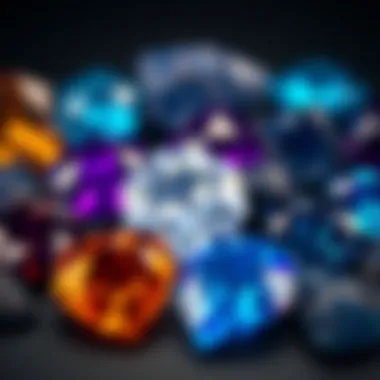

History and Origins
The origins of iolite and tanzanite are as distinct as their hues. Iolite, often referred to as the ‘water sapphire’, finds its roots deep in metamorphic rocks, particularly in regions like Sri Lanka, India, and Brazil. What makes iolite fascinating is its pleochroism — the ability to display different colors when viewed from different angles. Ranging from blue to violet, this stone captures the light in ways that often leave collectors in awe.
On the other hand, tanzanite is a gem that boasts a more recent historical timeline. Discovered in Tanzania in 1967, this blue variety of the mineral zoisite has taken the gemstone world by storm. Its rich blue-violet colors have made it synonymous with elegance and have elevated its status among collectors. The first tanzanite stones were unearthed in the Merelani Hills, giving it a unique geographical pedigree that’s highly coveted.
Overview of Collectibles, Rocks, and Fossils
Both iolite and tanzanite serve as splendid examples in the niche of collectible stones, each possessing unique features that stoke the passion of enthusiasts. Collectors appreciate iolite for its lesser-known but alluring characteristics, while tanzanite's vivid coloration and relative rarity make it a desirable prize in any collection.
- Keys to Recognition: Look for iolite's distinctive color changes when viewed from various angles. In contrast, tanzanite is best identified by its vibrant dual colors, especially under natural light.
- Market Trends: As demand rises, especially for tanzanite, collectors navigate a landscape where supply is limited. This rarity may influence its market value significantly.
Historical Significance and Cultural Impact
The significance of these gemstones stretches far beyond their physical beauty. In many cultures, stones like iolite and tanzanite have been assigned various symbolic meanings. For instance, iolite has been used by the Vikings for navigation, as the stone helps discern direction, while tanzanite has become a symbol of transformation and has deep-rooted connections with various spiritual practices.
Tanzanite, particularly, has woven itself into modern culture, frequently seen in jewelry worn by celebrities and members of high society. This association gives it a flair that resonates with those who seek not only beauty but also a story behind their gemstones. The relatively recent addition of tanzanite to the gemstone market has also led to its rapid rise in popularity — a phenomenon that reflects evolving tastes in the realm of jewelry.
The rich, deep hues of tanzanite make it a favored choice for special occasions, often being gifted during significant life events, reinforcing its status as more than just a stone but as a cherished keepsake.
Identification and Classification
Identifying and classifying these two unique stones is vital for any collector looking to add genuine pieces to their collection.
Guide to Identifying Rocks and Fossils
- Visual Inspection: Iolite usually appears in a deep blue to violet hue, often accompanied by visible inclusions that can help identify authenticity. Tanzanite, with its vibrant blue or violet colors, is harder to miss but can be mimicked; hence, knowing the intricacies of both is key.
- Hardness and Durability: Iolite ranks a 7.0 to 7.5 on the Mohs scale, while tanzanite sits at around 6 to 7, indicating that although both are reasonably durable, care must be taken with tanzanite.
Common Types and Variations
Both iolite and tanzanite come in distinct forms, contributing to their overall appeal. Iolite, especially, can vary in color saturation, while tanzanite can show variations based on its cut and source.
- Iolite Variants: Commonly found in darker or lighter tones, each variation presents its own unique charm, appealing to different aesthetic preferences.
- Tanzanite Cuts: The stone is often faceted, but cabochon cuts are also appreciated for showing off its depth and brilliance.
In sum, understanding the history, origins, and distinguishing characteristics of iolite and tanzanite provides invaluable insights for both novices and veteran collectors. Both stones tell tales of nature's artistry and the rich cultures that appreciate them, making them worthy additions to any collection.
Prologue to Iolite and Tanzanite
The world of gemstones is rich and diverse, and among its sparkling inhabitants, iolite and tanzanite stand out for their unique characteristics and allure. These two gems not only differ in their aesthetic appeal but also in their origins and the stories they tell. As we delve into their comparison, it’s crucial to grasp why understanding these stones matters, particularly for rock and fossil collectors eager to enrich their collections with vibrant and meaningful specimens.
Iolite, often recognized for its beautiful blue to violet shades, can exhibit a phenomenon known as pleochroism, where it displays different colors when viewed from different angles. This quality lures both jewelers and collectors alike. Tanzanite, on the other hand, is a product of a much more recent discovery, boasting a captivating blue-violet hue and a rare presence that makes it highly desirable. Its colors shift dramatically under varying light conditions, adding another layer of complexity to its appeal.
By exploring both stones in detail, one can gain insights into their geological formation, their market value, and the factors influencing their beauty. Understanding these aspects not only enhances one’s appreciation of the gemstones but also equips collectors with the knowledge to make informed decisions when purchasing. Moreover, it aligns with the growing trend among enthusiasts who seek to own pieces with distinct stories—each gem represents a journey from deep within the Earth to the display cases of jewelers.
As we embark on this comparative journey, we will unravel the unique attributes of both iolite and tanzanite, pondering what makes each gemstone special and why they may appeal differently to the discerning eye of collectors. Whether it’s their vibrant colors or their historical context, every facet of these stones serves to enrich our understanding and appreciation of natural beauty.
"In the realm of gemstones, every piece tells a story, inviting us to explore the magnificence of the Earth’s treasures."
As the article unfolds, readers will find themselves better equipped to identify, appreciate, and ultimately select between these two stunning gemstones.
Defining Iolite
In the realm of gemstones, a crystal's definition encompasses much more than its mere appearance. Iolite, also known as the "water sapphire", plays a significant role due to its fascinating geological and aesthetic properties. Understanding iolite is essential for appreciating not only its beauty but also its historical significance and practical applications.
Geological Formation
Iolite forms in metamorphic rocks and is primarily found in regions where volcanic activity occurred. Developed under specific conditions involving temperature and pressure, it often emerges from the transformation of magma into a crystalline structure. This metamorphic process gives rise to iolite crystals that can vary in size and shape, resulting in unique specimens that collectors cherish. The locations where iolite is mined, such as parts of Sri Lanka and Brazil, also influence its quality and features, making geographical aspects an integral part of its identity.
Chemical Composition
The chemical formula of iolite is (Mg,Fe)2SiO5 - a magnesium iron silicate that sheds light on its formation. This dual composition contributes not only to its distinctive colors but also to its various qualities, including hardness and brilliance. Understanding this aspect allows collectors to assess iolite based on clarity, cut, and overall value. Its transparency can range from nearly clear to a deep blue or violet that change as light interacts—often termed pleochroism.
Color Variations
Color is often the first thing that catches the eye, especially when discussing gemstones. Iolite stands out because of its remarkable ability to display multiple colors from different angles. This characteristic makes it a captivating jewel and a subject of interest for both gem enthusiasts and collectors alike.
Pleochroism in Iolite
Pleochroism refers to the phenomenon where a gemstone shows different colors depending on the angle of light and the viewer's perspective. In iolite, this effect is particularly striking. You may see shades of blue, violet, or even gray, depending on the lighting conditions. This distinctive characteristic not only elevates iolite's aesthetic appeal but also influences its desirability among collectors. The variation in color adds depth to each individual stone, making each piece unique—a true prize in the gem collector's chest.
Different Hue Displays


When we delve into different hue displays in iolite, it becomes clear that this stone isn't just a one-trick pony. It's known for a spectrum that ranges across cooler tones—from rich indigos to soft lavenders. Each hue has its personality; darker shades of blue might convey a sense of sophistication, while lighter violet tones can feel fresher and more playful. Such diversity allows jewelers to create a wide array of designs that can cater to personal tastes and occasions. Moreover, this variability in hue presents both advantages and challenges, as consumers may need to educate themselves about how to assess and appreciate the subtleties of iolite. In the end, the vibrant palettes of iolite contribute significantly to its allure within the gemstone community.
Exploring Tanzanite
Tanzanite stands as a gemstone brimming with stories and significance. This section dives deep into its unique components, treating readers to a closer view of what makes tanzanite a coveted gem. Especially for collectors and enthusiasts, understanding its origin, composition, and color attributes provides essential insights that enhance one’s appreciation and knowledge of this brilliant stone.
Origin and Discovery
First discovered in 1967 by a Masai tribesman in Tanzania, tanzanite quickly captured the attention of gem enthusiasts. The region, specifically around the Merelani Hills, is the world’s sole source for tanzanite. Its striking blue-purple hue, a consequence of its unique composition, sparked a gem rush, as collectors and jewelers alike sought to procure this rare find. The gemstone was initially marketed by Tiffany & Co., a move that modernized perceptions of colored gemstones, making tanzanite synonymous with luxury, rarity, and sophistication in the jewelry world.
Composition and Structure
The allure of tanzanite is not just skin deep; it lies within its very structure. Composed of the mineral zoisite, tanzanite is rich in calcium aluminum silicate. This composition contributes to its stunning color clarity and desirability. Unlike many gems that boast simple structures, tanzanite possesses a unique trichroism that means it can display three distinct colors when viewed from different angles. This subjectivity to color adds layers of depth to the stone that collectors relish. Understanding its geological makeup helps enthusiasts gauge both its value and investment potential in the market.
Color Characteristics
The character of tanzanite rests heavily on its ability to shift hues, which elicits awe in both casual observers and seasoned collectors alike.
Shift in Colors Under Light
Tanzanite exhibits a striking shift in colors under different lighting conditions, typifying this dynamic stone. In daylight, it radiates an intense blue tone, while incandescent light brings forth more purples. This duality offers buyers versatility, appealing to a range of preferences. One key characteristic of this color shift is its allure; it can captivate and create a unique experience for the wearer. The value of tanzanite can often be affected by how prominently these colors shine through, making this aspect critical for consideratoin in the gem market. Notably, the color play of tanzanite often makes it a crowd favorite, resulting in increased demand, particularly for well-cut stones.
Comparative Shades
Comparative shades further enhance the conversation surrounding tanzanite and its appeal. While the blue-violet range is generally its trademark, some stones exhibit deeper or lighter shades based on their formation conditions. Collectors often debate these differences, as certain shades can be perceived as rarer and thus more desirable. The depth of color can influence how a piece of jewelry looks on the individual, making understanding these shades vital for someone considering investing in tanzanite. The distinct feature of these comparative colors underscores how gemstone quality can often be subjective, leading to individual interpretations of beauty and value.
"Understanding the nuances of tanzanite’s color variation is essential for anyone wishing to collect or work with this remarkable gemstone."
In summary, by exploring tanzanite’s origins, composition, and color characteristics, one gains valuable knowledge to make informed choices in the ever-evolving realm of gemstone collecting. This understanding not only enriches the collector’s experience but also augments the appreciation for this exquisite stone within the industry.
Comparison of Physical Properties
In the world of gemstones, the physical properties define not just their allure but also their practical utility. When one delves into the comparison of iolite and tanzanite, understanding their tangible attributes is essential. For collectors and enthusiasts alike, knowledge of these properties can influence purchasing decisions and enhance appreciation for these stones. Key elements such as hardness, clarity, and preferred cuts play a pivotal role in how these gems are utilized and valued in jewelry.
Hardness and Durability
Hardness is a critical factor in assessing a gemstone's durability. Measured on the Mohs scale, it provides insight into how resistant a stone is to scratches and wear. Iolite sits at about 7 to 7.5 on this scale, making it reasonably tough compared to many other gemstones. Conversely, tanzanite, while also considered durable, ranks slightly lower at around 6 to 7. This can lead to considerations for those who plan to wear their gemstones frequently.
Key Points:
- Iolite's resilience: With its higher Mohs rating, iolite withstands daily wear better than tanzanite, making it a stronger candidate for everyday jewelry, especially rings.
- Tanzanite's elegance: Although softer, tanzanite's stunning colors often make it a favored choice for more delicate jewelry pieces, such as earrings or pendants.
Understanding these rankings matters far more than just a number; it affects how often one might need to maintain or replace jewelry items made from these gemstones.
Clarity and Inclusions
Clarity refers to the presence of internal flaws, known as inclusions, which can affect a stone's visual appeal and value. In this arena, both iolite and tanzanite exhibit their own quirks.
Iolite typically presents with inclusions that can significantly influence its clarity. Many stones show a variety of small imperfections, but high-quality pieces display a captivating depth of color and clarity.
Tanzanite, on the other hand, frequently presents with a more significant number of inclusions. Still, the fascination lies in how these inclusions can sometimes enhance the gemstone's character rather than detract from it. Collectors often glean insights about a tanzanite’s origins from its inclusions, making these small blemishes part of its narrative.
Noteworthy Aspects:
- Iolite: A high-grade iolite exhibits exceptional clarity which can be appealing for collectors seeking visual perfection without noticeable flaws.
- Tanzanite: While inclusions are common, a collector may find beauty in the uniqueness they offer, often presenting a conversation starter regarding the stone's journey to your jeweler.
Cut and Shape Preferences
When it comes to cut and shape, both iolite and tanzanite offer options that cater to different tastes. The choice of gem cut can greatly influence the stone's brilliance and how it interacts with light.
Iolite is frequently cut into various shapes, but popular choices include ovals and cushions, as these cuts allow the pleochroic nature of iolite to shine. The distinct color shift seen in the stone is best showcased through skilled cutting, making this a crucial consideration for both jewelers and buyers.
Tanzanite is celebrated for its versatility in cuts, with a predilection for the emerald cut and pear shapes that enhance its vibrant blue hues. Such cuts can maximally display the stone's color saturation and depth, further elevating its desirability.
Collector Insights:
- Preferred cuts for Iolite: Buyers often prefer cuts that allow for pleochroism, revealing Iolite's stunning shifts in color.
- Tanzanite preferences: Stylized or sophisticated cuts are popular as they highlight the depth and rich renditions of color in tanzanite.
When selecting between iolite and tanzanite, considering physical properties like hardness, clarity, and cuts can greatly enhance your final choice, whether for use in jewelry or as prized collectables.
Identifying Iolite and Tanzanite
Identifying iolite and tanzanite poses both challenges and intrigues for gem enthusiasts and collectors alike. As these gemstones often exhibit similar hues, distinguishing between them is crucial not only for making informed purchases but also for appreciating their individual characteristics. The clarity with which one can identify these stones enhances their value and significance in the realm of jewelry and collecting. Understanding the unique traits of each stone expedites decision making while ensuring that the buyer is aware of the true nature of their purchase.
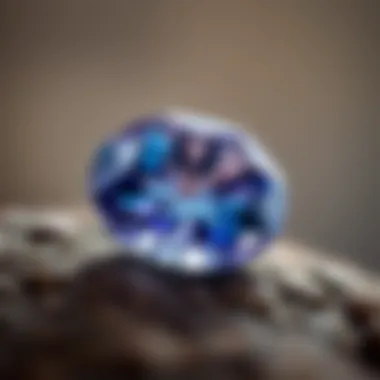
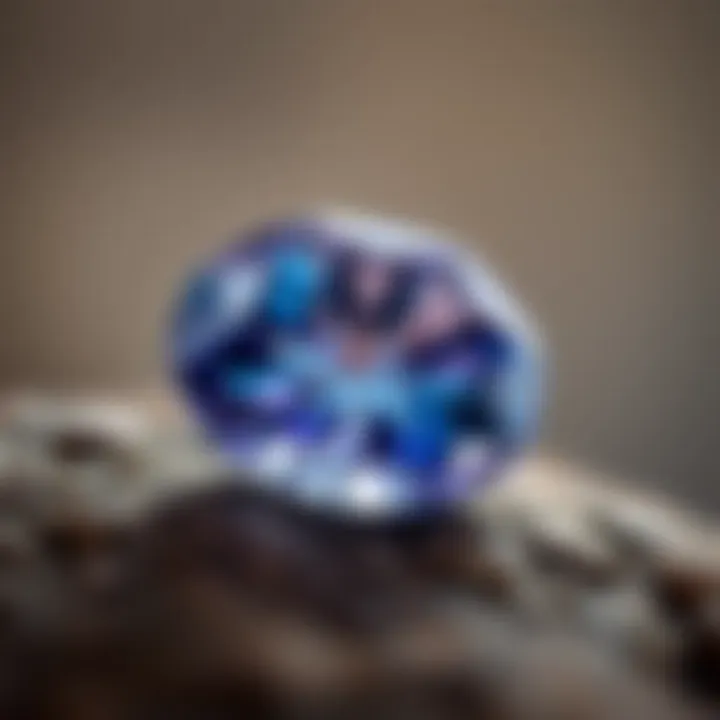
Visual Identification Techniques
When it comes to identifying iolite and tanzanite, visual techniques embody the first line of defense. Each stone presents a unique palette that, while somewhat similar, allows for differentiation with a keen eye.
Color Variability: Iolite is notable for its pleochroism – a trait where the stone changes color when viewed from different angles, displaying hues of blue, violet, and sometimes even gray. In contrast, tanzanite is predominantly blue with a hint of violet, often appearing purplish when viewed under different lighting. A collector can tilt the stones under a light source and observe this color-play.
Clarity and Inclusions: While both gems are generally clear, tanzanite often showcases distinct inclusions known as 'fingerprints' which may be absent in high-quality iolite. Under a magnifying lens, these nuances can provide clues to their identity. So, always keep a loupe at hand when examining these stones closely.
Cut and Shape: The design of the gem can also provide hints. Iolite is often cut into cabochons or cushions, while tanzanite is frequently faceted to maximize its shimmering appearance. This cutting preference aids the discerning eye in identifying which stone is which.
“In the world of gemstones, knowing how to spot the differences is akin to reading the fine print in an important contract.”
Testing for Authenticity
Once the visual identification stage is complete, the task shifts towards confirming authenticity. The market is rife with imitations and lesser-quality stones, making this step crucial for both collectors and jewelers.
Hardness Test: Iolite has a hardness of 7 to 7.5 on the Mohs scale, while tanzanite sits at 6 to 7. Conducting a scratch test on a less noticeable area can be a tell-tale method to determine authenticity. Though one must be cautious and avoid scratching the surface heavily, as both gems are prized for their appearance.
Light Test: Observing how each stone interacts with light can also help ascertain authenticity. A genuine tanzanite should display an alluring depth when illuminated, often appearing over a vivid spectrum of shades. Iolite, while also beautiful, exhibits a different kind of shimmer. Testing using UV light can additionally reveal more about the stone’s characteristics, as iolite may display a fluorescence uniquely different from tanzanite.
Professional Appraisal: If in doubt, reaching out for a professional appraisal can save both time and potential heartache. Experienced gemologists have the tools and knowledge that can bring about a confident identification. They might use advanced methods such as spectroscopy to analyze the light spectrum absorption properties of the stones, providing definitive proof of authenticity.
In summary, identifying iolite and tanzanite requires a mix of keen observation and practical tests. The nuances between the two gemstones can be subtle, but once grasped, they reveal an intriguing world. Collectors would greatly benefit from mastering these techniques to enrich their collection and ensure they are investing in genuine gemstones.
Market Value and Availability
When discussing gemstones like iolite and tanzanite, understanding market value and availability is key. This section sheds light on how these two stones are perceived in the market, their relative pricing, and what factors influence their availability.
Pricing Factors
The price of both iolite and tanzanite can fluctuate based on several crucial factors. First and foremost is the quality of the gemstone. This quality hinges on clarity, color saturation, and overall appearance.
- Color: Tanzanite, with its vibrant blue to violet hues, tends to attract a higher price point due to its striking color and rarity. Iolite, while equally beautiful, often features a more muted tone of blue and purples, making it less expensive.
- Size and Cut: Larger stones often command a premium. The cut also plays a role in pricing; well-faceted stones that reflect light beautifully draw in more buyers.
- Market Demand: As trends shift, the demand for specific stones can soar or dwindle. For example, if a celebrity sports a particular gemstone, that can skyrocket its value overnight.
In a nutshell, the interplay of these elements ultimately shapes how much you might pay to acquire either of these gemstones.
Sources and Mining Locations
Gemstones don’t just magically appear; their origins impact both their availability and value significantly. Let’s dig into where iolite and tanzanite come from to understand the implications.
Iolite Distribution
Iolite can be found in a range of locations across the globe, but its primary deposits are in Brazil, India, and Madagascar. The diversity of Iolite distribution is one of its intriguing characteristics that sets it apart.
- Variety: Because it can be sourced from multiple countries, iolite is somewhat consistently available in the market.
- Economic Aspect: The wider availability often translates into more reasonable pricing compared to rarer gems like tanzanite. Collectors looking to diversify can find a more affordable range of iolite stones.
- Mining Risks: However, mining conditions can vary. In some regions, regulations are lax, affecting sourcing ethics and sustainability. It's a double-edged sword where ease of access can sometimes compromise ethical considerations around mining practices.
Tanzanite's Exclusivity
On the flip side lies tanzanite, which is almost exclusively sourced from a small area near Mount Kilimanjaro in Tanzania. This exclusivity drives its desirability and price.
- Rarity: Because tanzanite has limited sources, its availability fluctuates based on market demand and quantity mined. As production wanes, the existing inventory becomes even more valuable.
- Investment Potential: Collectors often see tanzanite as a viable investment due to its potential to appreciate in value over time, especially as supplies diminish.
- Cultural Significance: In addition, its connection to Tanzanian heritage adds an emotional element that many enthusiasts find compelling, further increasing its market appeal.
The unique aspects of gemstone sourcing—whether it's widespread availability or singular exclusivity—significantly influence market value and collectability.
These facets of market value and availability not only inform the financial aspect of these gemstones but also help collectors make educated decisions about their investments.
Uses in Jewelry and Collecting
The fascination with gemstones extends beyond their aesthetic appeal—stones like iolite and tanzanite are prized not only for their beauty but also for their cultural significance and versatility in the realms of jewelry and collecting. Understanding how these stones are utilized provides insight into their value and the preferences of collectors.
Both iolite and tanzanite offer unique color properties and qualities that cater to various styles and occasions.
Popular Jewelry Designs
When it comes to popular jewelry designs, both iolite and tanzanite have carved out their niches. Their inherent characteristics lead to distinctive applications.
- Iolite: Often referred to as the "water sapphire," iolite exhibits a range of hues—most notably deep blues and violet shades. This versatility allows it to fit into various settings, from elegant rings to simple yet sophisticated earrings. Its pleochroism—where it appears different colors from different angles—can add depth to designs, making it a favored choice among designers aiming for visual intrigue. Jewelry pieces often feature:
- Tanzanite: This gemstone's rarity and enticement come from its rich, vibrant hues ranging from deep blue to purplish tones. Due to its singular origin in Tanzania and captivating colors, tanzanite is popular among luxury jewelry designs. Noteworthy trends include:
- Striking cocktail rings embedded with larger iolite stones to showcase the gem’s rich color.
- Delicate pendant necklaces that flaunt a subtle yet vibrant hue.
- Bracelets with alternating stones, creating a harmonious balance in color.
- Luxurious statement rings, often featuring tanzanite as the centerpiece, surrounded by diamonds for contrast.
- Elegant drop earrings that allow the stone’s light-catching properties to shine.
- Custom necklaces that highlight the unique color shift of tanzanite, making each piece feel completely personal.
Collector Preferences
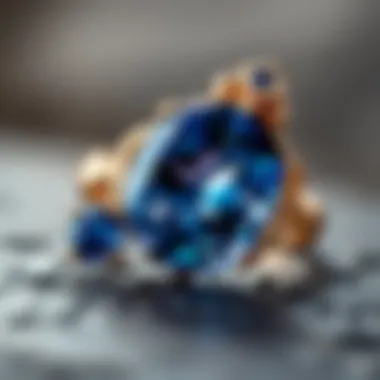
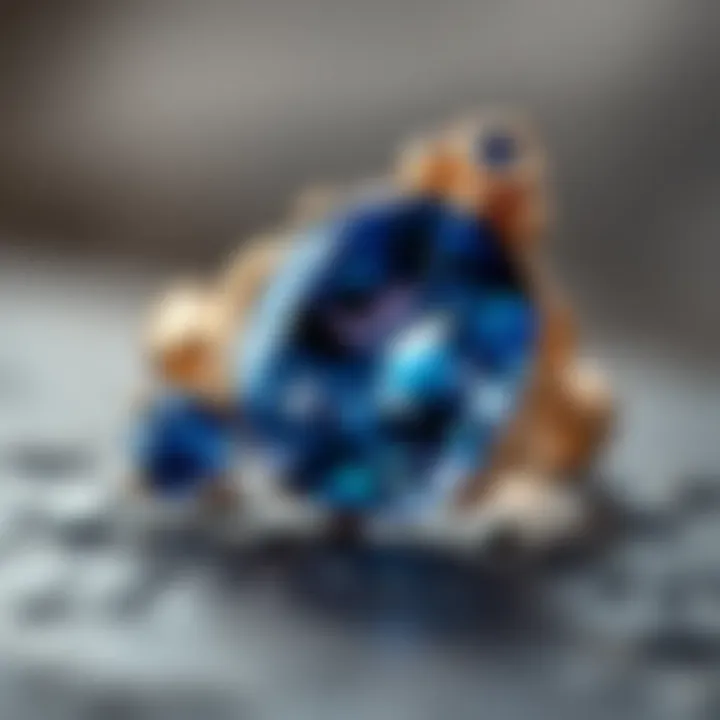
When it comes to collector preferences, the choices made can be as individual as the gems themselves. The decision often revolves around factors like color intensity, cut quality, and rarity. Collectors display varying inclinations when it comes to these two stones:
- Iolite collectors often seek stones with the most distinctive pleochroism, as this feature sets iolite apart from other blue stones. They also explore:
- Tanzanite enthusiasts typically focus on the stone's clarity and saturation, as well as its high demand in the market. With its limited geographical source, many collectors prioritize:
- Raw stones for their natural beauty, valuing uncut forms as displays of mineral formation.
- Cabochon shapes that enhance the stone's color play.
- High-quality pieces with deep blues, even considering the stone's grading challenges.
- Unique cuts that maximize the rich hues and brilliance.
This interest reflects a broader appreciation and investment, as both stones have a unique place in gemstone collecting. Each collector brings a personal touch to their collection, whether it originates from aesthetic desires or the quest for historical significance.
"Collecting gemstones like iolite and tanzanite isn’t just about owning a piece of nature; it’s about preserving a piece of history that tells a story of Earth itself."
Whether for personal adornment or as collectible assets, understanding the uses of iolite and tanzanite enhances appreciation for these striking gemstones. Their dual roles—both as beautiful components in jewelry and as coveted collectibles—ensure they will be cherished for generations to come.
Care and Maintenance for Both Gemstones
When investing in gemstones like iolite and tanzanite, understanding their care and maintenance is vital. Both stones, while beautiful, have unique properties that require careful handling to preserve their luster and integrity. Proper maintenance not only enhances their appearance but also contributes to their longevity, making them valuable additions to any collection.
Cleaning Techniques
Keeping your gemstones clean is essential for maintaining their clarity and brilliance. Here are some effective cleaning techniques specific to iolite and tanzanite:
- Gentle Soap Solution: Mix a few drops of mild dish soap with warm water. Use a soft cloth or a brush with soft bristles to gently clean the stones, focusing on any crevices or settings where dirt may accumulate.
- Avoid Harsh Chemicals: Chemicals such as bleach or ammonia can damage these precious stones. Always opt for gentle, natural cleaning methods.
- Rinse Thoroughly: After cleaning, rinse the gemstones in clean, lukewarm water to remove any soap residue. Make sure to dry them with a soft, lint-free cloth.
- Ultrasonic Cleaners: While not all gemstones tolerate ultrasonic cleaners well, tanzanite generally can. However, it’s crucial to check with a gemologist, as the stone's structural integrity can be compromised if the inclusions are too prominent.
In summary, frequent and gentle cleaning is fundamental in keeping both iolite and tanzanite looking their best, but care must be taken to avoid methods that could inadvertently harm them.
Storage Recommendations
The way you store your gemstones significantly affects their preservation. Proper storage can guard against scratches, exposure to moisture, and varying temperatures. Here are some tips:
- Individual Pouches or Boxes: Store iolite and tanzanite separately in soft pouches or lined boxes. This prevents scratching and minimizes the risk of damage from other jewelry.
- Avoid Sunlight: Prolonged exposure to extreme sunlight may cause tanzanite's color to fade over time. Therefore, keeping gemstones in a dark, cool place can help maintain their vibrant hues.
- Climate Considerations: Aim for a stable environment. Humidity can lead to mildew or tarnish on jewelry settings, while extreme dryness may cause stones to crack.
- Regular Checks: Periodically inspect your gemstones for any signs of wear or damage, such as loose settings. If you notice any issues, consider consulting a professional jeweler.
To encapsulate, the diligent care and meticulous storage of both iolite and tanzanite are pivotal in retaining their beauty and value. Treating these gemstones with the respect they deserve ensures that they remain breathtaking pieces for years to come.
"Gemstones are not just stones; they are treasures that carry stories of the earth beneath our feet. Treat them well."
For more detailed guidelines on gemstone care, you may visit Gemstone Care or Gemological Institute of America.
Understanding how to maintain these precious gems enhances both their beauty and longevity, serving as an insurance that your investment is well protected.
Cultural Significance and Symbolism
The cultural significance of gemstones extends far beyond their physical beauty; it dives into the essence of human beliefs, traditions, and historical narratives. Both iolite and tanzanite carry intricate meanings and are often associated with particular symbols and usages throughout various cultures. Understanding these aspects provides valuable insights for collectors and enthusiasts alike, enriching their appreciation of these unique minerals.
Historical Contexts
Iolite and tanzanite have woven themselves into the fabric of history across different civilizations. Iolite, often called the "water sapphire," has been linked to the Vikings, who supposedly used its pleochroic properties to navigate the seas. They believed that by looking through iolite, they could see the sun's position, even when clouded over.
On the other hand, tanzanite has a relatively modern discovery tale, having been found in the 1960s in Tanzania. Despite its youth, the gemstone quickly gained a significant place in the cultural landscape—especially in Africa. Its rich hues and rarity have made it a symbol of the cultural heritage of East Africa, celebrated in local art and jewelry. Furthermore, the gemstone has been adopted by many as an emblem of tranquility and spiritual awareness, significantly influencing the designs of jewelry crafted from it.
"Gemstones have always embodied the soul of the peoples who treasure them, capturing their dreams and aspirations through the ages."
Myths and Legends
The allure of iolite and tanzanite is further enhanced by various myths and legends. In gemstone folklore, iolite is believed to possess the ability to bring clarity and vision to its wearer. Ancient tales suggest that it promotes the third eye's spiritual faculties, aiding in the perception of one's inner truth. Many see it as a stone that can guide individuals in finding their path.
Conversely, tanzanite's rich blue and violet tones have been intertwined with indigenous stories that celebrate its vibrant colors as reflections of the sky at sunset. It is deemed a stone of transformation, believed to connect individuals to their higher selves and enhance their intuitive abilities. This legend bears importance for collectors, as it creates an affinity between the stone and its user, enhancing its perceived worth beyond mere monetary value.
In summary, both iolite and tanzanite escape mere classification as beautiful stones. They have layered meanings built through history, myths, and culture, making them not just collectibles but artifacts of human expression and belief.
End: Iolite vs Tanzanite
In wrapping up our exploration of iolite and tanzanite, it's paramount to underscore the significance of understanding these two gemstones—not only for their aesthetic appeal but also for their unique geological origins and characteristics. Each stone carries its own narrative, one that is steeped in both natural wonder and cultural relevance. For collectors and enthusiasts, the nuances of iolite and tanzanite extend beyond mere beauty; they symbolize personal connection and investment.
Final Thoughts
Iolite and tanzanite both present distinct qualities that can captivate the eye and the heart. Iolite, with its striking pleochroism, exhibits shifts in color depending on the angle of light—a fascinating attribute indeed. In contrast, tanzanite’s rarity and its dramatic color change further accentuate its allure, showcasing deep blues and purples that can enchant anyone who lays eyes on it. Each gemstone not only serves an aesthetic purpose but also participates in the rich tapestry of human artistry and expression through jewelry.
When considering these stones, it’s crucial to recognize what you value most. Are you drawn to the robust nature of tanzanite, despite its higher market price and more delicate structure? Or does the captivating play of color and affordability of iolite speak to you? They allow for an appreciation of nature's beauty while also offering an entry point into the gemstones' broader narrative.
Making an Informed Choice
Choosing between iolite and tanzanite goes beyond personal preference; it engages practical considerations too. Here are a few pivotal points to keep in mind:
- Purpose of Purchase: Will you wear the gemstone daily, or is it primarily a collector's item?
- Budget Constraints: Tanzanite generally commands a higher price due to its scarcity. Ensure that your purchase aligns with your financial means.
- Durability Needs: If you're after durability for day-to-day wear, consider the hardness of each; tanzanite, though stunning, is softer compared to the toughened nature of iolite.
Moreover, delve into authenticity checks and learn how to identify real specimens, particularly as the market burgeons with enhanced replicas. Resources such as GIA, Mindat, or relevant forums on Reddit are invaluable for budding and seasoned collectors alike.
In essence, whether you’re swayed by iolite's enchanting hues or tanzanite’s celebrated charm, making an informed decision invites lifelong enjoyment, appreciation, and perhaps a flourish of storytelling as you share your discovery with others. Embrace this opportunity to enrich your life with the wonders of these remarkable gemstones.



